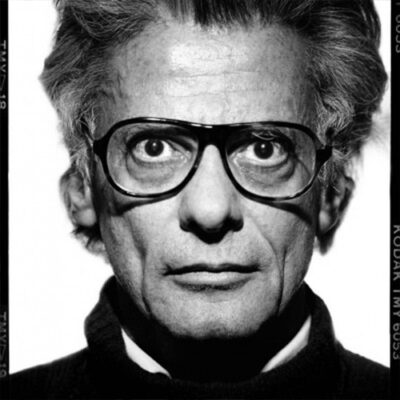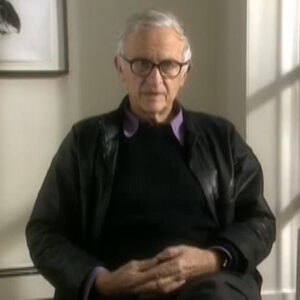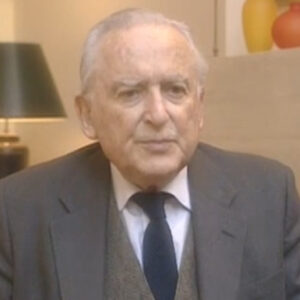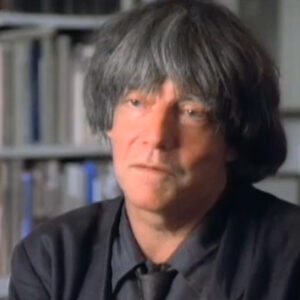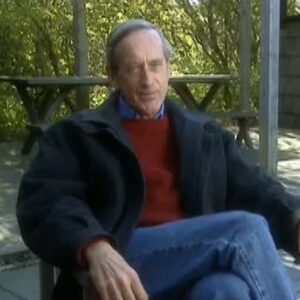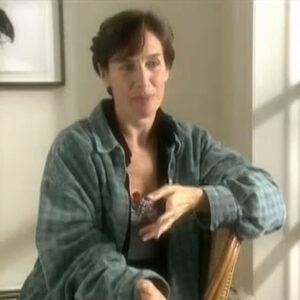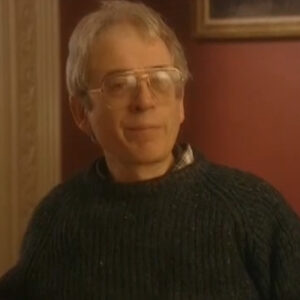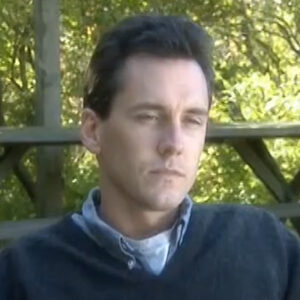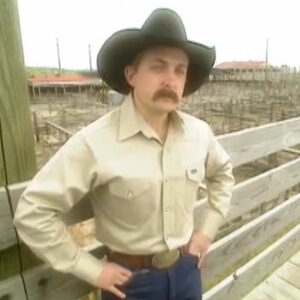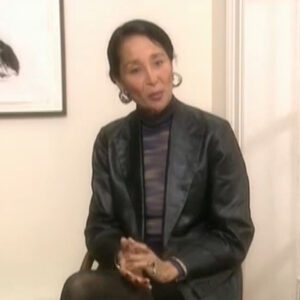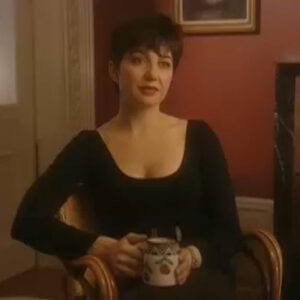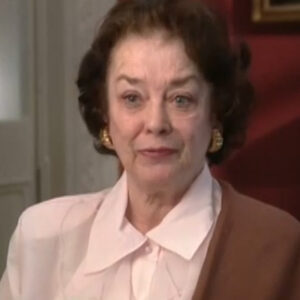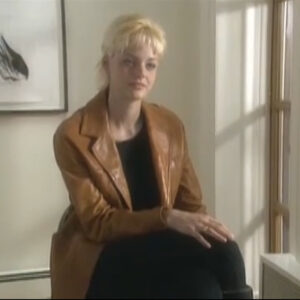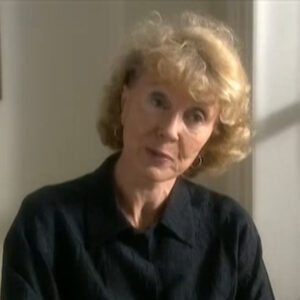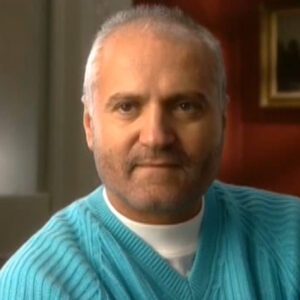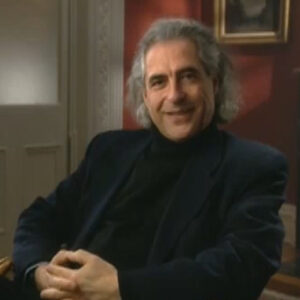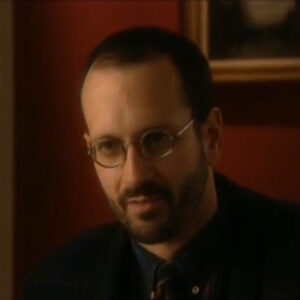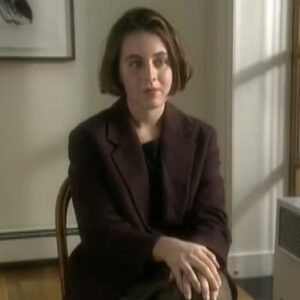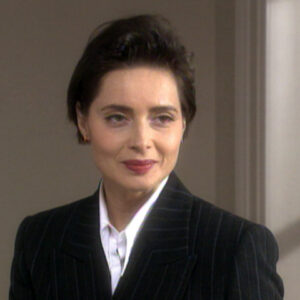Speaker Well, the first my first Anderson book was given to me by a woman who I consider sort of godmother. She’s in Spanish. Noble woman who had met Denison in Europe. She’s a friend of of Eugene Walters. And she was beautiful, wild black hair. And she wrote poetry. And she was the first mother figure who was also a sexual figure to me. So the book came charged. And I love Denison’s work sort of in my early 20s.
Speaker And I, I still take it with me. It was a kind of not a Bible that’s too corny. It was a book that I turned to for comfort because she’s so wise about loss and she’s so hopeful about actually discovering your identity if you’re if you have a sense of fate and if you’re true to yourself. I found all her advice for wisdom useful. And in the 70s, I was back from Europe and writing about Lost Women from Ms. Magazine, because I speak a lot of languages and I knew a lot of obscure women writers. And I wrote a piece on her and my editor for the book, Michael Danity, who had studied Dennison at Chicago with Hannah Arendt, wrote to me and said, Do you want to do a biography? I said, no. We met, we had dinner. He we talked about ideas. It seemed very glamorous, the whole project. But I still wanted to discourage him because I was terrified of taking on something so immense. So I screwed up my courage and I asked him for the most money I could bear to bring out of my mouth, which was 10000 dollars. And he said he thought he could get me the money. And so the advance was drawn up and I felt that I was signing like like an apprentice signing away her life, which is in fact exactly what I did. I signed it away for the for the next seven years. And then I just remember living in a state of constant anxiety about this book and this woman and this relationship. I wrote letters to everyone in Denmark. I studied Danish, and I finally went over there and began to meet her family and the people who had known her and her disciples. And the original book contract was for three years after the third year passed, I was nowhere remotely even into the first draft. I went to Africa. Peter Beard was very kind to me. He had me out to Montauk and he gave me a pep talk and he said, go and stay at my ranch, which I did sort of alone there. And I, I did get the feeling of her of her Africa riding on the game reserve by myself, which was crazy and amazing. I’m here to tell the tale. Her brother was still alive. Her old friends in Kenya were still alive. Now they’re all dead. Beryl Markham was still alive. There were these extraordinary ancient figures, difficult to talk to because they were British and very reserved. But there was there were enough living witnesses to be to make it a very compelling adventure. And then there were her archives, which no one had ever unsealed. It was really like walking into a tomb of Pharaoh’s tomb. Nothing had been catalogued. Nobody had gone through it before me. And I only realised now that I’ve that I’m working on a writer, Collette, who’s been written and written and written about how lucky I was with Tennyson. But I struggled with her and she has a parable that she uses Angel Joseph Joseph wrestling with the angel. And at the end Joseph says to the angel, I will not let that go until you bless me. And I really felt that afterwards. In retrospect, that was true of Denison, that that was after I let go, that she gave me her blessing in a strange way and I could let down my guard in a way I felt much closer to her when the book was behind me. I was I was very wary of her as I was writing the book. Everyone is voicing. Don’t you identify with her? Don’t you put yourself into her soul and become her. And that was the one thing I really was not going to do. You asked me about my perfume before I discovered it was one of those sort of little karmic coincidences that she wore. Fucka was fairly obscure French perfume, and it was the perky might always loved and. When Time magazine did a did a piece on biography and they tried to peg me as the biographer who identified with the subject to the point of losing her own identity, I told the story about Africa. And that came out as the paradigm. You know, Thurmon identified with her subject so much she wore the same perfume to evoke her. But it’s a very intimate relationship. So I sometimes think of myself as her.
Speaker It’s her last surviving relative role.
Speaker My relationship with Dennison. I’m Dennison’s biographer, but it’s really like an early marriage. You get into it before you know what’s involved. I took on the project thinking I could do it in three years. It took seven. I had to learn Danish. I went. I lived in Denmark. I lived in Africa. I met her family. I met her disciples. I had to pass all kinds of tests of worthiness. I lived in Africa. I met the last surviving colonial settlers. Really? Now they’re all dead. A whole generation is now dead. And I wrestled with her for four, seven years, which is a good biblical number.
Speaker And where did you end up in the field without her? We’ll talk about the fortress.
Speaker Well, people say, do you like her? It’s so beyond. It’s so complex. It’s so beyond love or hate. It’s a feeling that you have for a parent or a spouse. Tremendous familiarity. Tremendous intimacy. And a sense of having. Of struggling with somebody for access to their inner life. I like her. Oddly enough, I feel closer to her now that I’m writing another biography. And and, above all, am involved with another. And in a way, much more difficult, elusive woman. I feel much closer to her. I really think that she wanted to be known. And she she posed like the like the king in a fairy tale. She made it very difficult. She made it a feat. If you could pass the tests. Pull the sword out of the stone. She would let you into her secrets.
Speaker You know.
Speaker Well, I know that Dennis and hated the photograph and she wrote she she wrote a Trump party to tell him how ungallant she thought they had both been in Sweet-Talking her in a way, and then taking what she felt were these dreadful, unflattering pictures. Her vanity was wounded. However, I see the picture both as a wonderful reading of her true character and as the kind of prank that she herself with more with with more humor might have appreciated.
Speaker On the one hand, Denison was a ravenous woman, greedy for life, greedy for experience, and in a more down to earth way, greedy for food. She was an anorexic. She stopped herself. She said she wanted to be the thinnest person in the universe. She lived on speed. The picture captures the glazed, dilated pupils of the speed freak. And this was all this. Greed was something she disavowed. She she really, in a way, presented herself as someone who had outlived her life, someone the spectre of the past, someone who had triumphed over her own feelings of loss, who had no more desire, who spoke with the the wisdom of the grave. And the picture captures this wild eyed, mischievously smiling, greedy and beautiful but distorted face.
Speaker So they got her. And it took me years before I found out about the anorexia and the speed and the the bingeing and the dieting and all of her her. Her relationship to food and hunger and to desire and loss. I also see the picture as an edible prank. The prank of two talented young men. The prank that they play on a grand old lady. The grandioso lady. Also Truman Capote is text is very reverent, but there is a tension between the text and the photograph, which restores a kind of wonderful perspective to Dennison’s Schrade. She presented herself, especially in this country, with her furs and her accent and her title and her people would address her in the third person as baroness. She presented herself as a figure of tremendous glamour. And I think that was one reason why she agreed to be photographed by Avedon because he had such a reputation for photographing beautiful women. So she was she felt betrayed. She felt that this great connoisseur of beauty was going to capture her beauty of her old age. And instead, they captured something much more primitive, a primitive quality that she took great pains to conceal.
Speaker It’s another quality he spoke about.
Speaker She said the quality of the transgressor talk at about that, whether I’ve been weaving in that story, which Abberton has told many people about how she tested him to make the case question. And the transgressor. All those.
Speaker Yes.
Speaker Dienst said great store in transgression and wanted to be thought of as a great sinner. She wasn’t his greatest sinner as she would have liked to be, but her alter ego, Miss Malon, Night Natto Day in the daily ordinate is is a woman of about 50 who looks back and imagines herself to have had the blackest of pasts. She admired the snake charmer. She admired people who would risk their lives unnecessarily.
Speaker That was one of her mottos. Come, let us go and risk our lives unnecessarily for. They have got any value. It is that they have got no value at all. She, her young protege, Torkild Bjorn Big. She wanted him to have erotic adventures with dangerous women. Of course she was very jealous when he did. She. This was her reaction, really, against the puritanical upbringing and values of her mother’s family and her idealization of her father’s erotic prowess, his prowess as a hunter and the freedom that he renounced when he married. Or the freedom that he that he compartmentalized when he married her mother. Africa to her represented the land of the instinct’s the Mass. She loved the Maasai because they drank milk and blood and were figures of tremendous elegance and fearlessness. So she.
Speaker She had it and she was at odds with the Danes because of the harmlessness, the sort of marvelous, functional, matured character of Danish society. There was something she admired, a certain kind of adolescent recklessness, which she would not have called adolescence, she would have called it and rightly so heroic. You see it in the wildness of the eyes. You see it?
Speaker Yes, I see in this portrait a wildness, an avidity, an avidity for.
Speaker For experience that was definitely there. There’s a.
Speaker She.
Speaker You think I can turn it off? SEC.
Speaker Denison wanted to be perceived as a great transgressor, ironically, and what’s so interesting about this portrait is that Avidan was the transgressor. He transgressed the propriety of a certain presentation of this grand old lady. He caught her with her spiritual pants down in a way showing all the greed, the recklessness, the openness that she took pains to conceal. It’s it’s a picture. It’s an angle that almost nobody saw. She was very composed. She was she wore her marvelous had. She had a wardrobe that were very stylish clothes. She spoke with great distance and hauteur. And he he was the transgressor transgressing her expectations for this picture. I think that one thing I’m sure that she knew of his work, I’m sure that Kaposi told her about him, that she’d seen his work in vogue and she loved beautiful women. She had a kind of Dandy’s connoisseur’s appreciation for beautiful women. She met Marilyn Monroe. One of the people she wanted to meet when she came to America was Marilyn Monroe. And she described her as having the energy of a young lioness. So there was something of a of the the delicate Haitian of sensuous flesh that turned her on.
Speaker She.
Speaker That’s what I think why Bjorn Borg appealed to her, she wanted to mold. She, of course, was she saw herself. She had syphilis. She was too old to have carnal relations. You would have, I’m sure, like to. But she she saw that that would have been unseemly. And unseemliness is the word rather than improper, which is the moral word. Unseemly is the aesthetic word. But she had a vicarious imagination for erotic transgression. I think what you see in that face is a face which takes its pleasure vicariously. And that’s also something she didn’t want the world to know about her.
Speaker When last.
Speaker We’re also talking about the cruelty of this or those later years and connect back to.
Speaker First, her letter. Right. Why did you try to sign it? All right.
Speaker Well, I. I’ve been told that when Avidan was introduced, it isn’t her first question. Her first words were not, hello, how are you? So nice to meet you. She’s. Have you read King Lear? And he was taken aback as he either had not read King Lear or he hadn’t read it. And since he was 16 and in high school. And then she said, I I always judge people on their response to King Lear in a very civilized way. And I think he didn’t quite know what to do. This was one of her tests. She was like the old witch in a fairy tale. You came to her castle and she would ask you an obscure question. And if you responded, then she knew she had found a playmate and liked the witch and the old castle. She was very lonely. She was lonely in her exceptionality. She was lonely in the way people idealized her. She was lonely in her sense of having been cut off from the best years of her life. So she was with search for a playmate. And if you could if you could sort of responsive quotation was her was a favorite form of foreplay for her.
Speaker So if you could quote her back, the lines that followed, the lines that she quoted you, she would adore you. And she was she probably took the disappointment. Well, he couldn’t play King Lear with her, but it was a test.
Speaker You get the sense of the exporters, one on the other one.
Speaker Well, especially in his portraits of masters, of the image of his of great visual artists, there is a sense of competition between what he sees and the portrait that he’s doing of these great seers, Sears and Sears, in his fashion photographs. You sense a joyfulness and abandon a lack of conscientiousness. Not in his professionalism, but just in the pleasure that the guiltless pleasure that he’s taking in the work. There’s a seriousness and a kind of anxiety in the portraits of artists, particularly of masters, that seems to be about competitiveness. He the SIDOR and the and the portrait taker and with Denison with old went with grand old women. You see this with his portrait of Chanel. It’s quite shocking. In its cruelty, Dennison accused him of cruelty, cruelty. I mean, I don’t think it’s cruel. It’s it’s his privilege to focus on whatever he wants to. But he takes a sort of shocking pleasure in focusing on Chanel’s wrinkles and the lower part of her face, this symbol of glamour, as he did with Dennis and the symbol of nobility. He captures her with prankish expression. And he’s looking for something, a grotesque quality in the faces of these of these great artists. He doesn’t want to commemorate. He wants to play the game of truth with them as they play with their subjects upon the pictures of Oscar Levant.
Speaker I didn’t know what was. And that was that was actually quite wonderful. I thought it might be Rasputin because they struck me as pictures of a divine mad. And in a way, they’re the paradigm for the whole show, because in them, in this face of this, with its overbite and its soulfulness and its grotesquerie, he’s captured all the qualities that he’s seems to have been looking for in his other subjects. This is someone on the edge. This is someone there’s a pathos. There’s a beauty. There’s a power to these pictures. There’s a strangeness. There’s a craziness to them. And they seem to resume the fascination that he has with his other subjects in a whole way. The fragments there are there are these wonderful fragments and they seem to be trying to compose a single image.
Speaker And it’s probably the image of Avidan. It’s probably the fragments of his own self portrait, because I don’t know, all artists seem to me to be looking for a mirror, trying to supply a mirror. That was probably not supplied when they were children. Why would you become an artist? It’s a terrible fate. The people who do seem to be gifted with tremendous capacity for feeling confusion. They struggle with and against narcissism, and that’s what the work of a photographer really is, you’re struggling against the narcissistic preoccupation with with an image and within it. As I go through the show, it strikes me that Avidan is looking through the camera, looking at other people, trying to find the truth about them as a way of composing an image of himself. There’s something of a of a quest here of a search. These are fragments of his own of his own face. And I suppose I do want to be too psycho analytical, but there’s something also in his fascination with intensity. I would speculate. I would I would suppose that like many people who are fascinated with those who live on the edge with madness and the grotesque. It’s a way to overcome a kind of numbness or to jump start his own feelings to to reach a state of intensity that is elusive to him. I think that’s also true of many, many artists who struggle with depression and who who idealize madness. That’s that’s certainly I don’t know. There’s certainly some numb some struggle with numbness at the heart of some of these images.
Speaker Said it better before.
Speaker And I can tell the Jenny know about these issues about celebrity glamour. Right.
Speaker Thereby idealisation and trying to connect it both to dig and for the role of photography. Right.
Speaker You talked about this isn’t the era of idealisation. Yes. What was that era and what role play? What did contribute to it?
Speaker Well, when Jackie Onassis died, somebody said that there were two remarks that I’ve I’ve retained. One is that she was the last figure who was really revered. And when I watched her, they replayed her walk through the White House. She was treated with such tremendous respect by the by. It was Charles Kuralt who was the moderator. The camera loved her. And I remember feeling a kind of offer her myself.
Speaker And it’s true. I thought you do not idealize anyone the way she was idealized and revered. It’s impossible. Certainly not. Hillary Clinton, certainly not any of the movie stars who are who are around now. And we’ve entered into this era of irony. So Avidan, I think he plays he plays both sides of that. He plays with the OR he’s done he’s done images of such shattering beauty and perfection that you are in all of them and of the women in them. And he’s done pictures that are so sort of scorchingly realistic that he seems in a way to be. Trying to escape from the aesthetic world. This other aesthetic world. And celebrities, very. It’s a strange obsession. It is the obsession of this era, which is a post religious era. The gods are dead. These are the new gods. They’re also our sacrifices. They’re like the old as tech sacrifices. We feed them and and worship them for a year until until they’re worthy of dying. But that stake. And there, I suppose if you think of myths, myths, or about the foibles, myths or the soap operas of Mount Olympus as the world turns and we we can’t worship anymore. But we that need the void is still there to be filled. And I think that’s what celebrities do. Glamour, it seems to me, gets its power from time. Glamour is anything is glamorous, that defies loss, that reassures you that lost can be survived very young and beautiful or glamorous because they are coming into bloom. They’re at the height of their powers, the heroic, glamorous, because they’re they’re the strongest and the best and they’re also ready to die. The mad or glamorous in a way, because they’re living on the edge. Those who live on the edge have the greatest of all glamour because risk, which is the point at which life and death rub up against each other. That’s the cutting edge of glamour. So I think Avidan, who’s a great connoisseur of that in his quote, nonfat in serious pictures in his in his portraits of people in mental institutions and homeless. He’s looking at one aspect of. Of the glamour equation, which is death and risk. And when he’s doing his fashion photographs, he’s looking at pure beauty. Desire, pure form.
Speaker That purity, which is the other aspect of glamour to these new images, shows the ways the old.
Speaker I think what’s nourishing is your own belief.
Speaker I think there’s an emptiness now too empty.
Speaker It’s it’s ironic. It’s.
Speaker You. I think.
Speaker I think it depends on your age. I think if you walk into the bedroom of a teenager and you see pictures of the stars up on the walls, it’s like walking into a hut in the third world and seeing icons of saints on the walls or or good luck charms. And it is about good luck.
Speaker These are the these are the images that that young people worship and and look to for luck. Luck in hunting, luck and mating. Good luck in in seizing the goods of the world and and of of of surviving, I think as you get older is probably happens in any year. But as you get older, the images lose their power because you’ve crossed to the other side. And the distance of you all glamour dissolves when you come close to it. So does celebrity. It’s distances required for it. And as you age, you do cross over to that other side and you can look back. So age collapse is the difference. But something in our culture has also collapsed. The difference, and I’m not sure exactly what it is.
Speaker Also talking because we live in this era of images that we seem to have lost, you go to pay attention or to or to read or pay attention to your wonderful descriptions of the five minute fix of the five minute jerk off the jerk off talk about, you know. Those words were part of a whole stream of washing all over us. Is there something that happens when I think this photograph was place next to a photograph? Shopping more images of the love that takes place since photography. A complex enough to or we just just skating offers a student two parts.
Speaker OK. So many of the images that we live among are really tools for masterbation.
Speaker All the glossy catalogs, so many of the magazines, so much of it. There they are. They are. They’re quick fixes of pleasure. They’re quick erotic fantasies. And in an age of instant gratification, you get very anxious for gratification. Doesn’t come fast. So they have to be perfect. The edges have to be perfect. The frame has to be perfect. The body has to be perfect. There can’t be any imperfection that would slow down the orgasm.
Speaker Great connoisseurs of pleasure always take things slow. And I think that that’s one of the great losses of this era, is that people have lost the pleasure as an art. And you can’t if you take it fast, you’re missing the process. And I think that photography was to generalize and say it’s not the fault of photography, but the more perfect that the more glossy and perfect film and images become, the the less effort you have to put into finding your own pleasure in them. I don’t think that there’s necessarily a leveling effect when you have serious art portraits juxtaposed next to other images. I think the serious work stands on its own. It commands your attention and it itself inherently slows you down, because when an image is complex, your mind adjust to the complexity and it makes you think just the way a beautiful sentence, you will always leap up at you. If you read it in a stupid magazine, the context is, I think quality triumphs over its context to a more or less larger, lesser degree.
Speaker What do you think?
Speaker Your field of fashion photography?
Speaker There’s a kind of pure energy and joy and beauty in the fashion pictures. Eliteness again, you know, Kundra has colonized the world. The lightness of being and its pejorative. But that’s not quite fair in a in a world laden with material cares and worries and things and money. There’s a lightness to those images.
Speaker That’s very liberating, very joyful, very pleasurable. You add a playfulness. And I think that’s also it was a quality that Dennison revered, that she sought the playfulness of those images. It’s a kind of divine playfulness. It’s it’s somebody with tremendous talent, enjoying his own talent and challenging himself, not in a academic way and not in in a solemn way, but in a joyful way.
Speaker Portrait’s.
Speaker I’m always interested to see the retrospective of a lifetime’s work, because as a as a biographer, I suppose I want to find out what makes the artist tick. And I suppose what makes Abbadon tick on the basis of this great show at the Whitney is seems to be what makes most artists tick. The search for a reflection of themselves in their subjects, the the intimacy of Avidan with his subjects is a way of of of exploring the condition of exploring the nature of intimacy with the pictures of his father, for example, are both tender and savage.
Speaker And that’s that tenderness and the savagery which seems to be at the heart of these pictures.
Speaker And of his attitude is, I don’t know, seems to be central to him, to his work.
Speaker He can be it’s quite capricious when he’s going to be tender and when he’s going to be savage. And the book that observations had to do with Truman Capote is is quite extraordinary in this sense. There are pictures of great beauties photographed with the utmost tenderness and care, and then pictures of people who might have been glamorous and beautiful, but to whom he’s chosen to portray in a grotesque fashion. So there’s there’s an anger here, too. Maybe the anger is part of his competitive feeling toward his certain of his subjects, the Masters and and and great old women whom he photographs.
Speaker I can do you. He’s saying, I can see you. I got you.
Speaker One last question, we don’t put it back in this section. You said it wasn’t quite clear in the transcript maybe. You know, you said.
Speaker The Davison’s portrait is a very conceptional picture which reveals Dick’s deep understanding of the word.
Speaker The Dennison portrait is is a work of literary criticism in a way, it’s a conceptual picture because it reveals that he really understands the deep project of her work. Anorexia is proportionate to the control required to become an anorexic. To starve yourself is proportionate to the desire to binge behind it. And he catches Dennison’s ravenous snus, which is in a way, the counterpoint to the tremendous control and restraint in her work. The disembodied voice that marriage, the tales she is, she reveals herself if you know how to read her, not as someone who has survived loss. But as someone who has experienced loss and.
Speaker I think that that he captures really the secret aspect of her work work, that the credit aspect that many critics missed and that I missed all along for a long time, too, until her old friend, Ingrid Lindstrom in Africa told me about the bingeing. And then it all started to make sense. The last line of the biography, which came to me long, long before I actually got to write it was a line of Denison’s. And then I was myself the lightest thing of all for fate to get rid of.
Speaker That is the irony. In a way. That Avedon understood about her.
Speaker And then how you get.
Speaker But before you did, you’re not with. OK. All right. So anorexia, bingeing, control.
Speaker If there’s ever. Yeah, I mean, just look at it. It’s an observation.
Speaker We all know that the force required to starve yourself is proportional to your desire to binge. And Denison, for all her control and her refinement and her the distance that she wished to pretend to the passions was a ravenous person. Avidan catches the greed. He catches the ravenous ness in her. She thought the picture was cruel. She thought it was ungallant. She thought it was unforgivable, even though she might have, since she had such a respect for the truth, seen its justice. But she preferred Peter Beard’s pictures, which are wonderful pictures, but they’re marvelously, majestically noble profiles. And she was seen by Peter Beard as she wanted to be seen. She was in control in the setting with Avidan. Avidan was in control.
Speaker That, I think is partly. That’s very interesting because who has control of the sitting? The subject or the photographer? And at what Abbadon makes clear in his portraits of Masters is that he is the one in control. He will make you beautiful. He will make you grotesque. They’re his pictures. So the possessive. Where the possessive. Whose pictures are the question of whose pictures are they? Is a fundamental one. And I think that’s where you can see some of the quite natural competitiveness in this intimate relationship. As intimate as a marriage brief. Very briefly, as intimate as a sex act.
Speaker I sat for a portrait once, and it’s very, very strange, unsettling experience to be at the other end of someone’s look.
Speaker One last thing, what the sun. Just keep it isolated from the elements in her face, the expression, the eyes, the mouth, just something set just against other things you’re talking about, OK?
Speaker The eyes are the eyes are extraordinary. And when you look at them, there’s a stone quality to them. And of course, Dennison lived on she said she lived on oysters and champagne. She really lived on Dexedrine.
Speaker And her the the enormous pupils are probably the result of of the speed that she was taking to give her energy to push you withheld food from herself and she took the drugs to give her energy. They’re also brilliantly shining. They’re the eyes of someone, in a way, having a vision, seeing something very strange that somebody that the the taker of the portrait isn’t seeing.
Speaker And they’re filled with reflections, sort of like the mirror in a Ramaiah, a concave mirror in which the mysterious scene. Mysterious background is reflected.
Speaker The nose is ageless. And it’s funny because she loved noses and she felt that the nose was the great the great feature that told your characters could be the nose of a 16 year old. The flesh is drawn up really like the curtains in an opera house that the flesh of the cheekbones, which is perfect because of the theatrical persona. And there’s something about this picture which for me is marvelously ironic. Dennison’s the great paradigmatic work, denison’s life. The first thing she ever did and the last piece of hers that was ever performed was a little marionette play called The Revenge of Truth, which is a title to warm the heart of a biographer. And in it, the moral of this little place that by morning all of these characters are at an inn and all the lies that they tell come true. So in a way, you could subtitle this picture The Revenge of Truth, because. The the unsaid in Denison’s work is suggested in it.

